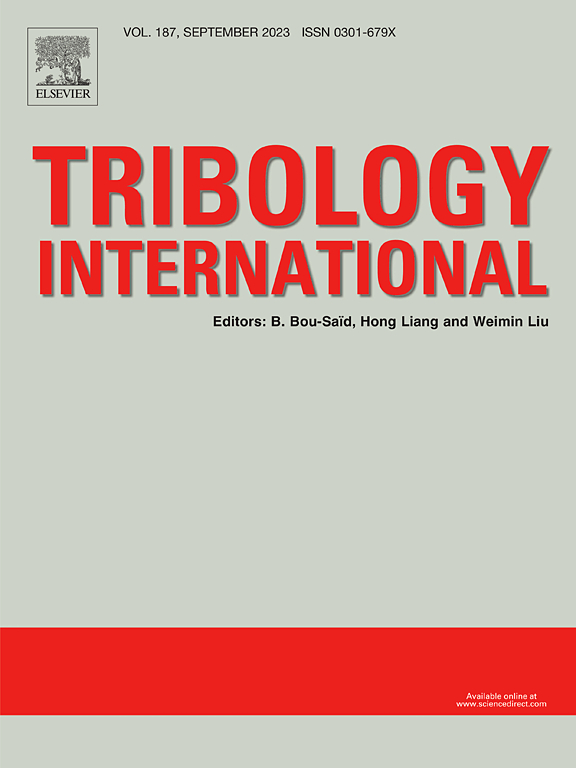Evaluation of Nanoparticles for Nanoscale Film Fabrication Harnessing Tribochemistry
IF 6.1
1区 工程技术
Q1 ENGINEERING, MECHANICAL
引用次数: 0
Abstract
Tribofilms, essential for reducing friction and wear in mechanical systems, are typically formed on contact surfaces through tribochemical reactions during sliding or rolling interactions. Nanofabrication of zinc dialkyl dithiophosphate (ZDDP) tribofilm provides an alternative manufacturing technique for developing micro/nano-scale structures and devices for applications other than reducing friction and wear. While ZDDP tribofilms can be fabricated with nanometer-level precision, the application of this tribologically fabricated thin film was limited by its electrically insulating nature. Nanoparticles, with their unique thermal, electrical, and optical properties, offer the potential to enhance the capabilities of fabricated tribofilms. This study investigates the role of five nanoparticles—WS₂, Al₂O₃, CuO, BN, and TiO₂—in the fabrication of tribofilms on a steel substrate. The thickness, distribution, and composition of the fabricated tribofilms were analysed. To accurately characterise the distribution and thickness of tribofilms, an innovative methodology utilising Conductive Atomic Force Microscopy (CAFM) has been developed. The results reveal that while the addition of WS₂, Al₂O₃, and CuO not affect the tribofilm composition compared with pure base oil, BN and TiO₂ are chemically incorporated into the tribofilm, altering its composition and potentially enhancing its functional properties.
利用摩擦化学评价纳米颗粒制备纳米级薄膜
摩擦膜对于减少机械系统的摩擦和磨损至关重要,通常是在滑动或滚动相互作用过程中通过摩擦化学反应在接触面上形成的。二烷基二硫代磷酸锌(ZDDP)摩擦膜的纳米制造为开发微/纳米级结构和设备提供了一种替代制造技术,用于减少摩擦和磨损以外的应用。虽然ZDDP摩擦膜可以以纳米级的精度制备,但这种摩擦膜的电绝缘性限制了其应用。纳米粒子以其独特的热学、电学和光学特性,为提高制备摩擦膜的能力提供了潜力。本研究探讨了五种纳米粒子——ws₂、Al₂O₃、CuO、BN和TiO₂在钢基体上制备摩擦膜中的作用。对制备的摩擦膜的厚度、分布和组成进行了分析。为了准确表征摩擦膜的分布和厚度,开发了一种利用导电原子力显微镜(CAFM)的创新方法。结果表明,与纯基础油相比,WS₂、Al₂O₃和CuO的加入对摩擦膜的组成没有影响,但BN和TiO₂被化学地掺入摩擦膜中,改变了摩擦膜的组成,并有可能提高摩擦膜的功能性能。
本文章由计算机程序翻译,如有差异,请以英文原文为准。
求助全文
约1分钟内获得全文
求助全文
来源期刊

Tribology International
工程技术-工程:机械
CiteScore
10.10
自引率
16.10%
发文量
627
审稿时长
35 days
期刊介绍:
Tribology is the science of rubbing surfaces and contributes to every facet of our everyday life, from live cell friction to engine lubrication and seismology. As such tribology is truly multidisciplinary and this extraordinary breadth of scientific interest is reflected in the scope of Tribology International.
Tribology International seeks to publish original research papers of the highest scientific quality to provide an archival resource for scientists from all backgrounds. Written contributions are invited reporting experimental and modelling studies both in established areas of tribology and emerging fields. Scientific topics include the physics or chemistry of tribo-surfaces, bio-tribology, surface engineering and materials, contact mechanics, nano-tribology, lubricants and hydrodynamic lubrication.
 求助内容:
求助内容: 应助结果提醒方式:
应助结果提醒方式:


